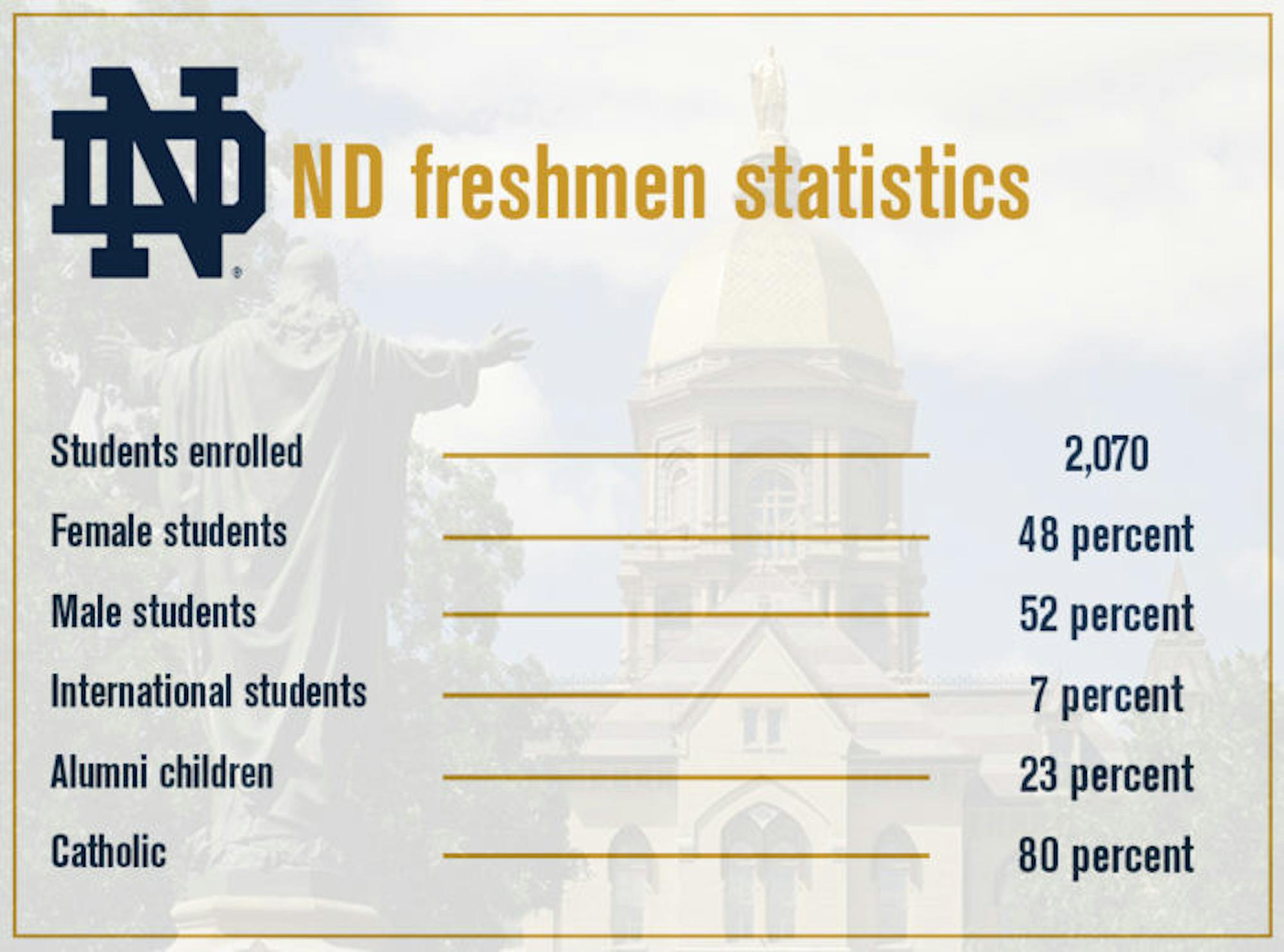
With the class of 2022, Notre Dame has seen its highest yield rate since 2002, in the pre-Common Application days: of the 3,608 students admitted, 2,070 will enroll this fall, associate vice president of student enrollment Don Bishop said.
The incoming first-year class will be about 20 students larger than previous years, an increase Bishop attributes to the University’s financial aid, additional recruitment and growing academic reputation.
“With 2,070 students they don’t have to be alike at all,” he said. “So it’s not just socioeconomic [status], how many low income, middle income [students], or race. It’s also kind of a state of mind and the approaches students take.”
This year, 20,371 students applied for admission to the class of 2022, Bishop said. Of the incoming freshman class, 38 percent were ranked in the top 1 percent of their class, and the middle 50 percent of the class scored between 1410 and 1540 on the SAT or between 33 and 35 on the ACT.
Still, these numbers aren’t everything, Bishop said. Two-thirds of Notre Dame applicants with an SAT score between 1500 and 1600 or an ACT of 33-36 were not admitted.
“We’re looking for students that are really interested in learning,” Bishop said. “So it’s not just their academic statistics — it’s their motivation for their success.”
In choosing the incoming freshman class, the University sought intellectually curious students who made the most of their resources, Bishop said.
“We’re really interested in ‘Did they maximize their opportunities within the environment they’re from?’ because our students come from many, many different backgrounds and we don’t want to have a cookie-cutter approach that only one type of background fits,” he said.
With students representing 66 countries, seven percent of incoming freshmen are international students, Bishop said. The incoming class is 80 percent Catholic and 26 percent are students of color. Additionally, 23 percent of incoming first years are children of alumni. The largest metro area for enrolled students is the New York City area, followed by Chicago.
“It really is part of the quality of education to have a diversity of backgrounds — socioeconomic, cultural, racial and even fields of study, even political backgrounds, people’s different points of view,” Bishop said. “There’s a very healthy view at Notre Dame and I think among the high school population now that the more diverse you are, the more aware you’re going to be of the world we’re going to set you out into in four years.”
Notre Dame will provide $147 million in undergraduate financial aid this year and 47 percent of students will receive need-based aid scholarships, Bishop said. Among the nation’s top 20 national private research universities, he said Notre Dame ranks in the top 10 for percentage of students receiving institutional financial aid.
Through increased recruitment efforts, the University attracted increased numbers of middle income and low income students, Bishop said. This year, 15 percent of incoming students are Pell grant recipients, first generation students and students with a family income of less than $60,000.
“We identify more schools of lower income and middle income and make sure we’re visiting them,” Bishop said. “We’re making sure that when students identify themselves as coming from those backgrounds … we try to connect with those kids as often as we can.”
The University also sought diversity of students’ academic interests and their varied approaches to learning, Bishop said.
“Part of diversity is having students that don’t know what they want to study at all, but also having a group that have a kind of pointed view of what they want to study,” he said. “You don’t want all students to have the same attitude towards their careers or their way of learning.
“There are some students that really want to walk into a field of study, find out what the requirements are and then just go do it and you have others that say ‘I don’t know what I’m going to do in ten years and I’m not worried about it. I’m just going to learn and take a broader look at my education.’”
Ultimately, however, there are certain shared characteristics that define the class of 2022, Bishop said.
“[We look for] kind of a sense of independence and drive but a healthy sense of drive, not this kind of self-inflicted ‘I have to be number one to be successful’ or ‘I have to be number one to be anything,’” he said.
Furthermore, Bishop said, this year’s incoming freshmen exhibited a desire to improve the world around them and gratitude for what others have done for them.
“I think that’s the Notre Dame brand,” he said. “I think our students, by self-selection, by recognizing the brand of the University, tend to be disproportionately interested in helping others, being kind.”
In an email, Bishop added that the admissions team “uses numbers to describe each new class more than we use numbers to select every new first-year class.”
“Notre Dame has a unique message that tends to cause students to self-select,” he said. “This is again the most qualified class statistically that we have ever enrolled. More important than their numbers that impress will be how the students joining our community choose to use their talents and how we engage them.”
Notre Dame class of 2022 brings increased enrollment
Dominique DeMoe | The Observer
Dominique DeMoe | The Observer









